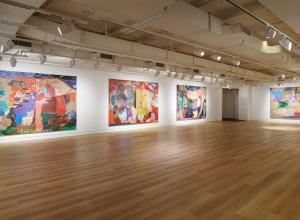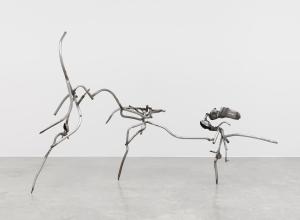Each of the 110 Art Nouveau and Art Déco jewels is a treasure in itself and reflects the passion of a collector, who surprised his wife with beautiful jewels from the beginning of the 20th century.
Art Nouveau was a brief moment (1895-1910) but it had a lasting impact on jewellery and examples from this period are treasured for their originality and design excellence rather than their intrinsic value. It was a complete new style based on original ideas, innovative materials and entirely different principals. In reaction to increasingly machine-made, mass-produced jewellery, free-floating forms from the natural world were explored as never before. Great artist-jewellers like Georges Fouquet and Henri Vever chose semi- and even non-precious materials for their creations. The undisputed master of this genre was René Lalique, whose genius oeuvre embodied the very essence of French Art Nouveau. His use of exotic and often fragile materials, particularly moulded glass and enamel, was revolutionary, as was his choice of iconography.
René Lalique (1860-1945) pushed the boundaries of his art in jewellery designs and his palette was much more diverse than of any painter or sculpture of this time and his work is a synthesis of all these arts. At first Lalique did not work under his own name and designed mostly for the major Parisian jewellery houses, such as Cartier and Boucheron, and finally in 1885 he started his own business. He then designed Sarah Bernhardt’s stage jewellery for the theatre, which gave him much acclaim. It must be remembered that, at that time, Art Nouveau was an innovative artistic movement reserved for the Parisian intelligentsia.
Whether it was magnificent creations for Mr. Calouste Gulbenkian or smaller jewellery pieces, all Lalique items could easily be worn since none were rigid, and they were almost invisibly supple. Lalique thought first and foremost of the person who was to wear his pieces—his creations are always soft against the skin, with the back as beautifully mastered as the front.
Beside the 45 pieces signed by Lalique the collector’s couple was also fascinated by jewels designed by Georges Fouquet (1862-1957). Georges joined his father’s business in 1891 and by 1900 he opened a new Boutique Fouquet at 6 rue Royale in Paris. For the interior design, he called on Alfons Mucha (1860-1939), Czech painter and decorative artist.
The collection contains several Art Nouveau jewellery pieces by Henri Vever, Eugène Feuillâtre, Léopold Gautrait, Vican, and Lucien Gaillard, beside the works of Fouquet and Lalique.
The abstract compositions and essential geometry of Art Déco (1915-1935) jewellery were daring and liberated, accompanied by vibrant chromatic contrasts and the innovative use of materials – coloured gemstones carved in the Indian style as flowers and leaves, or calibré cut in exotic shapes. Jewellers united East and West and formed with colour a synthesis of pure art and lasting luxury. Abstract, industrial shapes became increasingly massive and almost architectural in form as colour crept away from jewels to leave entirely white expanses of platinum, diamond and rock crystal or clean contrast of diamond and just one other colour. Sleek geometry gradually softened into more sculptural, three-dimensial shapes, rounded pleats, scrolls and spirals displayed the beginnings of volume and movements to complement the returning curves of femininity.
Raymond Templier and La Maison Templier spans over three generations. The founder, Charles Templier opened a jewellery shop in Paris in 1849. His son Paul succeeded him and the company flourished under his direction. Paul’s son Raymond joined after graduating from the École Nationale des Arts Décoratifs in Paris and he was the true artist of the family. Sketching at every moment, he would have filled his office floor by midday with sketches which would be evaluated in the afternoon. Raymond Templier’s talent was celebrated, earning him the title of the “architect of Jewellery” and many articles on him appeared in applied art journals.
Templier liked to juxtapose matte and glossy, black and white, full and empty, curve and straight lines. He said “Jewellery is above all about light and shadow, not just about glitter.”, as can be perfectly discovered in the above illustrated diamond and lacquer brooch made in 1929 (estimate: $45,000-65,000).
The sapphire’s octagonal-cut is sublime on lot 102 and the 1925 platinum work is characteristic of Templier, the metal is worked on multiple planes and forms waves, that give the piece a vibration, a rhythm (estimate: $25,000-35,000). The collection of Art Déco jewellery offers pieces signed by Jean Fouquet, son of Georges Fouquet, both innovative jewellers in Art Nouveau and Art Déco, as illustrated on the first page, a hexagonal onyx plaque pendant set with cabochon-cut emerald – representing the essence of Art Déco jewellery, made in 1925 (estimate: $90,000-130,000). The collection incorporates several works by Janesisch, founded in 1835 in Trieste, with a second and very active branch in Paris; clocks and watches by Cartier, jewels by Ostertag, a house which was only productive from 1920-1940; two rings by René Boivin and Paul Brandt, a Swiss jeweller who settled in Paris and who became famous for his extremely modernist geometric jewellery., as well as an extraordinary vanity case by Van Cleef & Arpels of Persian inspiration, which opens to reveal a mirror, two compartments and a lipstick holder, made in 1927 (estimate: $45,000-65,000).
Sales dates and locations:
Impressionist and Modern Art Evening Sale - November 2017 - New York
Post-War and Contemporary Art - November 2017 - New York
Magnificent Jewels - 13 November 2017- Geneva
Design - 20 November 2017 - Paris
African and Oceanic Art - 22 November 2017 - Paris
Post-War and Contemporary Art - 06 December 2017 - Paris
Tour dates and locations:
Paris - 7-10 September 2017 (highlights of all sections)
Moscow - 18-20 September 2017 (Kandinsky’s work only)
Shanghai - 22-24 September 2017 (Jewels only)
Hong-Kong - 28 Sept - 01Oct 2017 (Jewels and Modern Art)
London - 30 Sept – 7 Oct 2017 (Modern art only)
London - 13-18 October 2017 (Design only)
London - 16-20 October 2017 (Jewels only)
Tokyo - 22-24 October 2017 (Jewels only)
Taipei - 26-27 October 2017 (Jewels only)
New York - 30 Oct - 2nd Nov 2017 (Jewels only)
Geneva - 09-13 November 2017 (Jewels only)


























